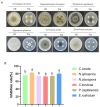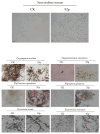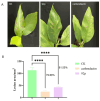Insight into Antifungal Metabolites from Bacillus stercoris 92p Against Banana Cordana Leaf Spot Caused by Neocordana musae
- PMID: 39766203
- PMCID: PMC11672926
- DOI: 10.3390/biom14121495
Insight into Antifungal Metabolites from Bacillus stercoris 92p Against Banana Cordana Leaf Spot Caused by Neocordana musae
Abstract
Banana crop ranks among the most crucial fruit and food crops in tropical and subtropical areas. Despite advancements in production technology, diseases such as cordana leaf spot, caused by Neocordana musae, remain a significant challenge, reducing productivity and quality. Traditional chemical controls are becoming less effective due to the development of resistance in target pathogens, which pose significant environmental and health concerns. Consequently, there is growing attention toward the development of biocontrol strategies. Here, we identified a new bacterial strain, Bacillus stercoris 92p, from the rhizosphere soil of banana. We evaluated its ability to suppress the growth of N. musae and other fungal pathogens that cause leaf spot disease in bananas. The inhibitory effect of B. stercoris 92p were checked using dual culture assays, microscopic observations, and pot experiments. Furthermore, the biocontrol mechanisms were investigated using whole-genome sequencing and biochemical analyses. The results showed that B. stercoris 92p exhibited significant antifungal activity against N. musae and other fungal pathogens, with inhibition rates exceeding 70%. Microscopic examination revealed significant morphological alterations in the hyphae and conidia of the tested pathogens. In pot experiments, B. stercoris 92p effectively reduced the severity of cordana leaf spot, achieving a biocontrol efficacy of 61.55%. Genomic analysis and biochemical tests indicated that B. stercoris 92p produces various antifungal compounds, including lipopeptides (fengycins and surfactins), hydrolytic enzymes (proteases and amylases), and phosphate-solubilizing metabolites. In conclusion, the study highlights that B. stercoris could potentially be used as a potential biological control agent against cordana leaf spot.
Keywords: Bacillus stercoris; Neocordana musae; antifungal activity; cordana leaf spot of banana; lipopeptide.
Conflict of interest statement
All authors declare that they have no conflicts of interest.
Figures










Similar articles
-
The Sigatoka Disease Complex Caused by Pseudocercospora spp. and Other Fungal Pathogens Associated with Musa spp. in Puerto Rico.Plant Dis. 2024 May;108(5):1320-1330. doi: 10.1094/PDIS-03-23-0433-RE. Epub 2024 May 3. Plant Dis. 2024. PMID: 37966473
-
Insights into Antifungal Mechanisms of Bacillus velezensis S141 against Cercospora Leaf Spot in Mungbean (V. radiata).Microbes Environ. 2023;38(1):ME22079. doi: 10.1264/jsme2.ME22079. Microbes Environ. 2023. PMID: 36935122 Free PMC article.
-
A rice rhizosphere plant growth-promoting Streptomyces corchorusii isolate antagonizes Magnaporthe oryzae and elicits defense responses in rice.J Appl Microbiol. 2024 Dec 2;135(12):lxae266. doi: 10.1093/jambio/lxae266. J Appl Microbiol. 2024. PMID: 39674266
-
Mycosphaerella fijiensis, the black leaf streak pathogen of banana: progress towards understanding pathogen biology and detection, disease development, and the challenges of control.Mol Plant Pathol. 2011 May;12(4):307-28. doi: 10.1111/j.1364-3703.2010.00672.x. Epub 2010 Nov 18. Mol Plant Pathol. 2011. PMID: 21453427 Free PMC article. Review.
-
Shotgun Metagenomics Reveals Bacteroides stercoris as a Fecal Biomarker Depleted in Late-Stage Hepatocellular Carcinoma.Gastro Hep Adv. 2024 Aug 30;4(1):100539. doi: 10.1016/j.gastha.2024.07.020. eCollection 2025. Gastro Hep Adv. 2024. PMID: 39895875 Free PMC article. Review. No abstract available.
References
-
- Jones D.R. Handbook of Diseases of Banana, Abacá and Enset. CABI International; Wallingford, UK: 2019.
-
- Perera N.T.T., Kelaniyangoda D.B. Fungal Leaf Spot Diseases in Banana (Musa spp.); Symptom Verification and Their Control (In Vitro); Proceedings of the 12th Agricultural Research Symposium; Makandura, Sri Lanka. 30–31 May 2013; pp. 136–140.
-
- Henuk J.B., Kadja D.H., Mau Y.S. Inventory and Identification of Banana Cultivar and Diseases Caused by Bacterial and Fungal Pathogens in West Timor, East Nusa Tenggara Province, Indonesia. Int. J. Trop. Drylands. 2020;4:10–16. doi: 10.13057/tropdrylands/t040103. - DOI
-
- Mathew D., Kumar C.S., Cherian K.A. Foliar Fungal Disease Classification in Banana Plants Using Elliptical Local Binary Pattern on Multiresolution Dual Tree Complex Wavelet Transform Domain. Inf. Process. Agric. 2020;8:581–592. doi: 10.1016/j.inpa.2020.11.002. - DOI
-
- Restrepo M.H., Groenewald J.Z., Crous P.W. Neocordana gen. nov., the Causal Organism of Cordana Leaf Spot in banana. Phytotaxa. 2015;205:229–238. doi: 10.11646/phytotaxa.205.4.2. - DOI
MeSH terms
Substances
Grants and funding
LinkOut - more resources
Full Text Sources

